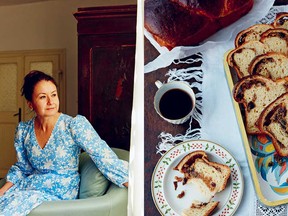Tava: Romanian baking book celebrates 'constellation of cultures'
In her follow-up to Carpathia, author Irina Georgescu shares Romanian baking recipes, tracing their roots throughout Eastern Europe and beyond

Reviews and recommendations are unbiased and products are independently selected. Postmedia may earn an affiliate commission from purchases made through links on this page.
Article content
Our cookbook of the week is Tava by Irina Georgescu. To try a recipe from the book, check out: Rose-petal jam crescents, Romanian festive bread with walnuts and raisins (cozonac), and Moldavian layered pie with hemp cream.
At home in Wales, Irina Georgescu recreates the flavours of her native Romania each Christmas. Baking cozonac, a twisted or braided bread filled with a mixture of walnuts and raisins, and fragrant rose-petal jam-stuffed cornulețe are holiday rituals.
Come New Year’s Eve, she bakes a layered chocolate cake, if she feels like something chocolatey. Or a feathery diplomat cake with rum-roasted pineapple, which was part of her repertoire long before she chose to feature it in her new baking book, Tava (Hardie Grant Books, 2022).
“Even if you go to Romania, a lot of people will say, ‘Oh, we’ll bake the pineapple cake for New Year’s Eve.’ (It’s) very modern, in a way. You know, it’s a diplomat cake, after all,” says Georgescu, laughing. “It’s cream and custard and stuff. We can’t really claim anything about it to be Romanian. But it’s so funny. That is so traditional for New Year’s Eve.”
Growing up in the Romanian capital of Bucharest, these were among her family’s holiday traditions. In other regions of the country, people celebrate differently. Swabians in the Banat region of western Romania, for instance, might honour the occasion with gugelhupf, strudel and a layered cake with buttercream, beautifully decorated. In eastern Romania, Moldavians traditionally enjoyed a 12-layer flatbread pie with hemp cream called Pelincile Domnului (“swaddling blankets of baby Jesus”) on Christmas Eve.
In Tava, Georgescu introduces readers to the baking traditions of six of Romania’s many cultural communities: the Magyars, Székelys and Saxons in Transylvania, the aforementioned Banat Swabians, the Armenians, whose ancestors settled in the 18th-century city now known as Bucharest, and the Jewish communities of Moldavia.
One foot in the present, one foot in the past, Georgescu crosses borders, tracing the roots of Romania’s baking recipes throughout Eastern Europe and beyond.
Tava means tray in Romanian and is a fitting title for a book featuring traditions from “a constellation of cultures.” Georgescu illustrates the ways in which these communities intersect, and how people celebrate with different breads and cakes.
“You look at the history and you understand all these layers and layers of ethnic groups that came to Romania, settled here and created this mosaic of people and of recipes and in cooking, as well,” says Georgescu. “And you just have these layers of culture and of history. It’s a bit like a cake, in a way, if you look at the layers of our ethnic history.”

The idea of focusing on Romanian baking traditions, tracing commonalities and differences, started with Carpathia (2020). In her cookbook debut, Georgescu devoted two chapters to baking: savoury breads and street food bakes, and desserts. The sheer number of recipes she had to shelve due to space constraints impressed on her just how important baking is to Romanians.
“Whatever we do, we end up baking something. When we celebrate something, we bake something. And we bake a pie, a plăcintă,” says Georgescu. “It’s the centre of how we cook, in a way. Because also plăcinte, this iconic dish in Romania, can be savoury. So, we have a plăcintă for a snack.”
Plăcinte are beloved pies with ancient roots. With two layers of dough, one below and one on top of a range of fillings (the most popular of which are apple and curd cheese), the plăcintă is classic Romanian home baking.
There are also folded plăcinte, which are fried or grilled flatbread-style, depending on where you are in Romania. (Georgescu features a recipe for Transylvanian griddle breads with cheese and honey in Tava.) “There is so much variety.”
Romanian baking traditions are built on the legacy of ancient Romans and Greeks, Georgescu writes, and bear the mark of Middle Eastern and Balkan, Austrian and German influences. “You can see that this diversity is coming together in a sort of culinary national identity. But if you look at the bigger picture, there is a lot of German-influenced baking.”
In the baking customs of the Saxons and the Swabians, for instance, this influence plays out in different ways. Lichiu (pie) — “the quintessential Saxon dish” — is very basic. In the past, it was made on bread-making days as a way of using every last bit of dough.
Bakers would make a flatbread and top it with whatever ingredients they had on hand, from a simple egg yolk-and-butter topping to fresh plums in the fall. The Saxons were renowned for their buffalo milk, Georgescu explains, so if they had sour cream or crème fraîche, they would have used that as well.
Traditionally, the Saxons celebrated every occasion with lichiu — whether Christmas, Easter, weddings or harvest time. They even ate it for breakfast with a glass of plum brandy before starting a hard day’s work.
“All of it was around this very simple idea of just dough topped with your basic staple ingredients in the community: the eggs and the dairy and the fruit in the garden.”
The elaborate cakes of the Swabians, who settled in Romania in the 17th and 18th centuries, roughly four centuries after the Saxons, are in stark contrast to the utilitarian lichiu, she adds. Layered with buttercream and topped with chocolate glaze, Swabian cakes were unparalleled.
“You can see even from only these two communities, ethnic groups, that the baking is so varied from basic, just dough with fruit, to something that uses a cake mould,” says Georgescu, referring to the tall, yeasted gugelhupf, studded with dried fruit.
It's a bit like a cake, in a way, if you look at the layers of our ethnic history.
Similar to the layer cakes she features in Tava — inspired by German-Swabian bakes and Eastern European pastry shops — Georgescu took a multi-tiered approach to writing the book. First, she spoke with members of the six cultural communities: People who are making history.
These included Caroline Fernolend, who established the Saxon self-sufficient village prototype in Viscri, and writer Paul Agopian, whose family settled in Romania after surviving the 1915 Armenian Genocide. Agopian’s website (negustorie.ro) is a resource unlike any other, Georgescu says, as he works to restore his family’s heritage and share the stories of Armenian communities in Romania.
“These are people who today are changing the landscape in Romania,” says Georgescu. “People who recovered their own traditions after the fall of the communist regime, and they actively did something to improve the community.”
Secondly, she pored over old cookbooks to piece together the past. There was essentially one cookbook during the communist regime, she explains, and much was lost.
After the fall of communism, Romanians started trying to recover cookbooks that were written long before the Second World War, which is no easy task, Georgescu underscores. Founded in 1859, Romania is a relatively young country. Seventeenth-century cookbooks from what is now Romanian territory would have been written in Hungarian or German.
Many of the earliest Romanian cookbooks are collections of international dishes, Georgescu explains. At the beginning of the 19th century, Romanians were fascinated by French cuisine, and there were many German and Austrian influences. In the late 19th and early 20th centuries, focus shifted to how people cooked in the countryside.
“It’s very encouraging that you can see how many people are passionate back in Romania about retrieving this Romanian cuisine. And bit by bit, discovering notebooks in the attic, or when houses are refurbished or they are modernized — old houses — people find different cookery books in there as well,” she says. “And they talk about them, or they go and print them, or they go and publish them somehow. So, it’s still the very beginning, but there is a movement toward reconstructing — really retrieving — a legacy of our cuisine, and that was also part of my research.”
The third layer was her own story: baking traditions passed down in her family and recipes inspired by experiences. Memories of saving pocket money to buy cream puffs and coffee éclairs at the pastry shop near her high school. The nostalgia of savarins and layer cakes, and the pumpkin and sour-cherry strudels her late mother and grandmother used to bake.
“I suppose for a lot of Romanians who live abroad, those will be quite interesting and a trip down memory lane in a way. Because you used to have them. It doesn’t matter that sometimes they didn’t really follow the classical recipe for something, but now in this book, you have the real thing. What they should have been during the communist regime,” says Georgescu.
As much as Tava is a historical and cultural journey, it’s also a personal one. “(It’s) what I remember and what I actually missed when I came to the U.K. to live here (in 2009). Thinking back to different recipes, I wanted them here in my book.”
Our website is the place for the latest breaking news, exclusive scoops, longreads and provocative commentary. Please bookmark nationalpost.com and sign up for our cookbook and recipe newsletter, Cook This, here.













Postmedia is committed to maintaining a lively but civil forum for discussion. Please keep comments relevant and respectful. Comments may take up to an hour to appear on the site. You will receive an email if there is a reply to your comment, an update to a thread you follow or if a user you follow comments. Visit our Community Guidelines for more information.